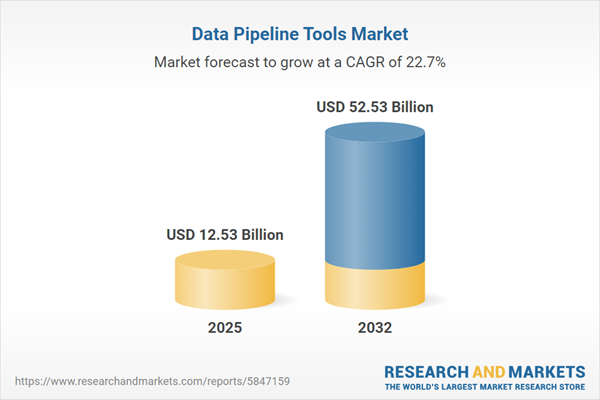Speak directly to the analyst to clarify any post sales queries you may have.
Data pipeline tools are fundamental for enterprise data management and compliance, equipping executive teams with adaptability and control to meet evolving regulatory and operational demands. These solutions serve as the backbone for aligning data strategies with business objectives, critical for maintaining effective, compliant, and streamlined operations.
Market Snapshot: Data Pipeline Tools Market Growth
The data pipeline tools market continues its upward momentum, driven by increasing digital transformation across enterprises, a mounting need for agile data frameworks, and growing regulatory scrutiny. As organizations modernize their data architectures, these tools become essential for supporting innovative business models and regulatory obligations. Vendors are responding by refining their platforms to suit sector-specific requirements and boost operational flexibility. The resulting environment is one where operational resilience, scalability, and quick adaptation to shifting regulatory trends determine long-term enterprise value.
Scope & Segmentation: Data Pipeline Tools Market
- Component: Advanced batch and streaming ingestion, orchestration, and observability features enable robust ETL pipelines, facilitating deployment in multiple environments such as data lakes and warehouses.
- Deployment Mode: Organizations can select cloud, hybrid, or on-premises models, aligning deployments to fit IT governance, security demands, and cost strategies.
- Data Type: Integrating real-time streaming with batch processing enhances cross-functional collaboration and accelerates analytics initiatives.
- Organization Size: Scalable and flexible products address the distinctive operational needs of enterprises, midmarket firms, and SMBs.
- End User: Business analysts, IT personnel, engineers, and data scientists benefit from collaborative, governance-oriented workflow environments.
- Pricing Model: Licensing, subscription, open-source, and pay-as-you-go formats allow organizations to align spending with budget cycles and project timelines.
- Industry Vertical: Configurable tools enable industry-specific compliance and integration for BFSI, retail, information technology, telecom, healthcare, and public sector applications.
- Regional Coverage: Cloud readiness, infrastructure investment, and legal standards across the Americas, EMEA, and Asia-Pacific define adoption rates, compliance requirements, and strategic vendor initiatives.
Leading participants—including Informatica LLC, IBM, Oracle Corporation, SAP SE, Microsoft Corporation, Talend S.A., Dell Boomi, MuleSoft, SnapLogic, and TIBCO Software Inc.—are enhancing products to meet the expanding needs of integration, security, and compliance within diverse enterprise environments.
Data Pipeline Tools: Key Takeaways for Senior Decision Makers
- Implementing unified governance frameworks improves oversight, supporting consistent operations and simplifying compliance across departments.
- Adopting modular, extensible architectures allows organizations to quickly address regulatory changes and facilitate smooth technology migrations.
- Integrated automation and observability offer streamlined audit trails, enhancing the efficiency of both internal and external compliance reviews.
- Flexible deployment models accommodate sector-specific needs and evolving data residency requirements, supporting compliance across jurisdictions.
- Industry-tailored features enable business and technical teams to control data flows in alignment with business and regulatory drivers.
- Regulated sectors such as finance and healthcare benefit from specialized tools that help maintain mandated standards and process integrity.
Tariff Impact: Strategic Responses to 2025 Tariffs
Amid new US tariff policies, enterprises are reassessing investments in data pipeline tools, especially where hardware costs present exposure risks. Cloud and hybrid models now appear attractive by reducing reliance on physical infrastructure. Vendors are responding by refining pricing and introducing region-targeted packages, allowing organizations to sustain dependable data operations while mitigating the impact of shifting international tariff costs. These developments enable stronger alignment with compliance needs and increased operational security under variable global market conditions.
Methodology & Data Sources
This analysis combines executive interviews, industry-wide surveys, and rigorously validated market data. Scenario-based modeling and peer review processes ensure the findings are reliable and relevant for senior decision-makers evaluating investments in data pipeline tools.
Why This Report Matters: Data Pipeline Tools Market
- Guides executive teams through changing global compliance and risk landscapes to secure operational consistency and informed resource allocation.
- Delivers actionable segmentation and strategic guidance for effective infrastructure decisions and capital planning.
- Enables organizations to build resilient and adaptive data architectures that can respond to ongoing shifts in technological and regulatory requirements.
Conclusion
Data pipeline tools underpin agile and compliant enterprise strategies. Senior leaders may use this report to align data management and operational practices with evolving business, risk, and policy objectives.
Additional Product Information:
- Purchase of this report includes 1 year online access with quarterly updates.
- This report can be updated on request. Please contact our Customer Experience team using the Ask a Question widget on our website.
Table of Contents
3. Executive Summary
4. Market Overview
7. Cumulative Impact of Artificial Intelligence 2025
Companies Mentioned
The companies profiled in this Data Pipeline Tools market report include:- Informatica LLC
- International Business Machines Corporation
- Oracle Corporation
- SAP SE
- Microsoft Corporation
- Talend S.A.
- Dell Boomi, Inc.
- MuleSoft, LLC
- SnapLogic, Inc.
- TIBCO Software Inc.
Table Information
| Report Attribute | Details |
|---|---|
| No. of Pages | 196 |
| Published | October 2025 |
| Forecast Period | 2025 - 2032 |
| Estimated Market Value ( USD | $ 12.53 Billion |
| Forecasted Market Value ( USD | $ 52.53 Billion |
| Compound Annual Growth Rate | 22.6% |
| Regions Covered | Global |
| No. of Companies Mentioned | 11 |









